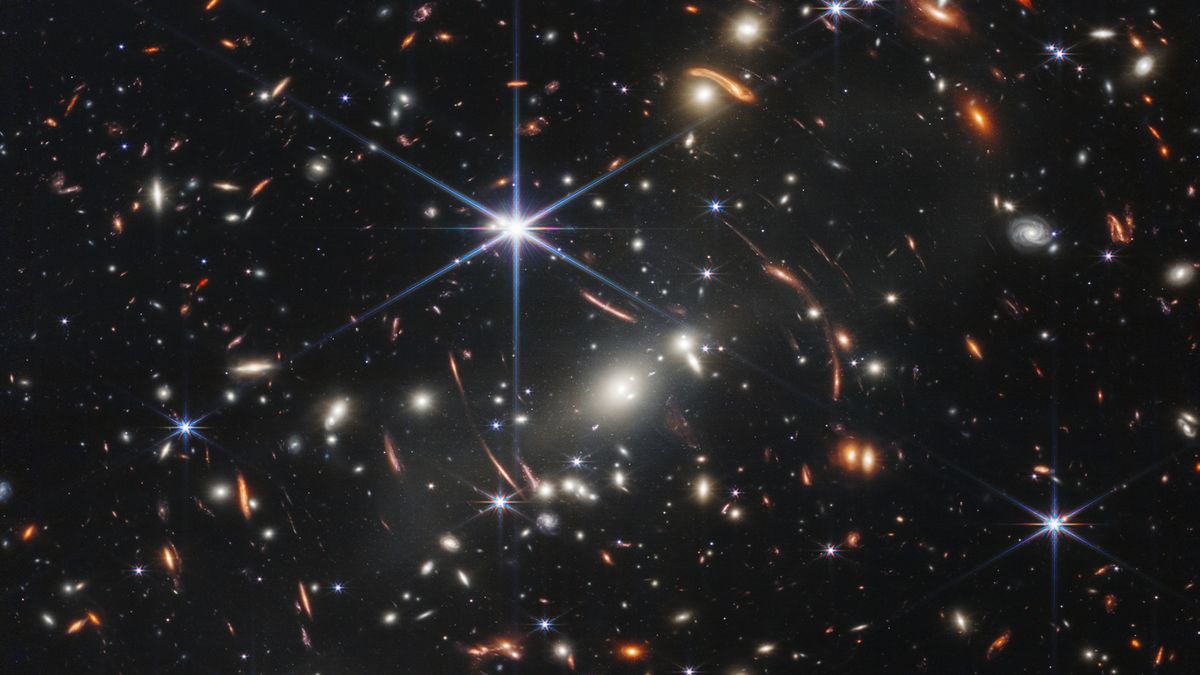
Not long after the James Webb Space Telescope began operations, astronomers announced that they had discovered galaxies in the early universe that were larger, brighter, and full of stars for their ages. While headlines around the world claimed that these galaxies “break” our understanding of the Big Bang, the truth is much more complicated—and much more interesting.
The Big Bang theory is our general picture of the history of the universe, beginning in its deep past, when the universe was much smaller, hotter, and denser than it is today. The model, first developed in the early 20th century, has passed a battery of observational tests and is remarkably adept at explaining a variety of cosmological observations, including the red shift of light from distant galaxies, the appearance of residual radiation in the form of the cosmic microwave background, the abundance of light elements, and the evolution of galaxies and larger structures.
Although the Big Bang theory cannot say for certain which galaxies will appear where, it can talk about probabilities. For example, cosmologists can say roughly how many small, how many medium, and how many large galaxies of a given size should exist at a given age in the universe. But until the James Webb Space Telescope, we have had no direct access to the earliest stages of galactic evolution—something the telescope was specifically designed to study.
In 2022, astronomers announced that they had found extremely distant and surprisingly large galaxies. They measured redshift Of the galaxies that number more than 16, which means that these galaxies It only existed 200 to 250 million years after the Big Bang.However, it was huge and appeared to be fully formed, with spiral arms and everything.
Related: No, the Big Bang Theory is not “broken.” Here’s how we know.
These galaxies seemed so far removed from the predictions of the Big Bang theory that they were like finding teenagers in a kindergarten classroom. So what was going on?
Curved cosmology
Bold headlines declared the Big Bang theory dead. But these stories omitted a crucial detail: Astronomers had measured the redshifts of these galaxies using a technique known as photometry, which is highly uncertain. A full assessment of whether these galaxies could “break” cosmology will have to wait until a more accurate measurement of their redshifts, and thus their ages, is available.
When those more precise measurements came back a few months later, the galaxies had gone from record-breaking to just ordinary galaxies. For example, one galaxy’s redshift was revised from more than 16 to just 4.9, pushing its age from 240 million years after the Big Bang to more than a billion years. That’s more than enough time for the standard Big Bang theory to explain their sizes and shapes.
But alongside those less exciting reviews, some confirmed redshifts have emerged for other galaxies, including JADES-GS-z14-0, the most distant galaxy currently known, with a redshift of 14.32. This galaxy was alive and well when the universe was only 290 million years old.
Astronomers predicted that galaxies would exist 290 million years after the Big Bang, which is why they built the James Webb Telescope. As galaxies go, JS-Z14-0 is certainly small—it’s only 1,600 light-years across, compared to the Milky Way’s 100,000 light-years. But interestingly, the galaxy is also fairly bright and full of stars—not enough to outright break cosmology, but enough to raise some questions about the origins and evolution of the first galaxies in the universe.
Building Cosmology
It is very likely that the Big Bang theory is wrong; scientists must have the mental discipline to acknowledge that possibility. But with such an overwhelming amount of evidence supporting the theory, it is unlikely that the Big Bang theory will be disproved by a single observation. It is worth repeating that the James Webb Telescope is doing exactly what we designed and built it to do: answer some of the key remaining questions about how the first stars and galaxies came into being.
It is quite possible that cosmologists could explain the appearance of galaxies like JADES-GS-z14-0 in the context of the Big Bang without having to make any major modifications. For example, black holes Perhaps these galaxies appeared before our own, and perhaps their super-strong gravity caused bright bursts of star formation. Or perhaps Supernova Feedback and other mechanisms caused the first galaxies to become much richer in stars than today’s galaxies, making those early galaxies appear large despite their small size.
Our initial observations may be biased toward these small but bright galaxies, and further campaigns may reveal larger populations of more mundane galaxies, thus reducing tension with galaxy formation models.
Finally, we may need to add some new ingredients to the universe, such as allowing dark energy to evolve over time, to produce this type of galaxy at such early times.
That’s interesting in itself, without having to overturn the Big Bang theory as we know it. There are enough mysteries and hidden corners of the universe to keep astronomers up at night wondering about the possibilities—and in the morning continuing to work out how to solve them.

“Web maven. Infuriatingly humble beer geek. Bacon fanatic. Typical creator. Music expert.”





More Stories
Scientists confirm that monkeys do not have time to write Shakespeare: ScienceAlert
SpaceX launches 23 Starlink satellites from Florida (video and photos)
A new 3D map reveals strange, glowing filaments surrounding the supernova